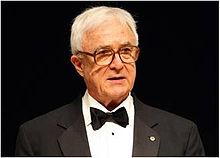David E. Kuhl
David Edmund Kuhl (born October 27, 1929 in St. Louis , † May 28, 2017 in Ann Arbor ) was an American nuclear medicine doctor. He is known for pioneering tomographic imaging in nuclear medicine .
Life
As a student, Kuhl won the Westinghouse Talent Competition after injecting rats with uranium salts and taking autoradiography recordings. He received his bachelor's degree in physics from Temple University in 1951 and received his master's degree from the University of Pennsylvania in 1955 with subsequent specialist training (internship 1955/56). 1956 to 1958 he was with the US Navy, where he headed a unit for nuclear medicine at the US Naval Hospital in Portsmouth (Virginia). He then returned to the University of Pennsylvania, where he was first assistant instructor in radiology (completed residency in residency in radiology residency in 1962), then instructor, assistant professor in 1965, associate professor in 1967 and finally professor in 1970 and head of the from 1963 to 1976 Nuclear Medicine Department at the University of Pennsylvania Hospital. From 1976 he headed nuclear medicine at the University of California, Los Angeles (UCLA), and from 1986 at the University of Michigan (Professor of Internal Medicine and Radiology), where he headed the PET Center. In 2011 he retired.
plant
Even as a student he drew attention to himself when, shortly after Benedict Cassen's nuclear medicine scanning method became known , he developed improved methods, for which he received a prize in 1955. From the end of the 1950s, he and the engineer Roy Edwards developed tomographic recording methods, both of which were continuously refined.
In the 1980s, his group ( Michael Phelps , Heinz Schelbert, Edward Hoffman, Henry Huang) at UCLA developed positron emission tomography for clinical applications, whereby he himself mainly dealt with functional imaging of the brain (e.g. PET with FDG tracer in epilepsy and Alzheimer's). Before that, he and others at the University of Pennsylvania had taken the first single-photon emission computed tomography (Spect) image with the fluorodeoxyglucose (FDG) tracer , and he also developed Spect further.
Honors and memberships
In 1981 he received the Ernst Jung Prize . In 1976 he received the Nuclear Medicine Pioneer Citation and in 1995 the Georg Charles de Hevesy Nuclear Medicine Pioneer Award from the Society of Nuclear Medicine, in 1989 the Javits Neuroscience Investigator Award from the National Institutes of Health and in 1996 their Benedict Cassen Prize. In 2001 he received the Kettering Prize , in 1996 the Outstanding Researcher Award from the Radiological Society of North America and in 2009 the Japan Prize. He was an honorary doctorate from Loyola University. In 1989 he was elected to the Institute of Medicine of the National Academy of Sciences .
Web links
Individual evidence
- ↑ Life data according to American Men and Women of Science , Thomson Gale 2004
- ↑ Markus Schwaiger: Professor David E. Kuhl has died. German Society for Nuclear Medicine, June 20, 2017, accessed on July 9, 2017 .
| personal data | |
|---|---|
| SURNAME | Kuhl, David E. |
| ALTERNATIVE NAMES | Kuhl, David Edmund |
| BRIEF DESCRIPTION | American medic |
| DATE OF BIRTH | October 27, 1929 |
| PLACE OF BIRTH | St. Louis |
| DATE OF DEATH | May 28, 2017 |
| Place of death | Ann Arbor |
